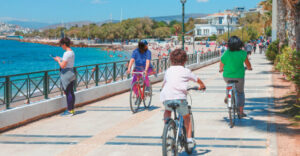Until now, if someone decided to enjoy a bike ride on the coastal front of Attica, they would regret it. His life would become…a bicycle, as he would be forced to move between pedestrians and cars on Poseidon Avenue or risk a potentially serious injury by falling on branches or – worse – into one of the open manholes – as some people insist on stealing the caps and selling them for scrap.
This picture is changing radically as now cyclists will be able to pedal on the Athenian Riviera from the Port of Piraeus to the Peace and Friendship Stadium and from there to Moschato to the town hall of Vouliagmeni.
The major project announced by Prime Minister Kyriakos Mitsotakis three years ago, during the presentation of the redevelopment of Attica’s coastal front, namely the creation of a bicycle and pedestrian path, is getting underway. Tomorrow, Monday, Attica’s regional governor Nikos Hardalias will present the project for which he will sign the contract with the contractor.
After that, “race” will begin so that the construction of the bicycle path can start, which will pass through six municipalities of Attica, while it will include interventions designed as part of a comprehensive approach to upgrading the coastal front area, with the plan to include infrastructure and landscaping projects.
The layout
By when will the bike path be ready? The ambitious project, which is considered one of the most important redevelopments in the basin as it will change the image of Attica’s coastal front, has a completion deadline of 510 days from the day the contract is signed. Government sources say that by the autumn of 2025 the coastal cycle and pedestrian path will be ready.
And so Athenians and non-Athenians alike will have the opportunity to cross the Athenian Riviera, from Kallithea to Vouliagmeni, with their bicycles, without dangerous detours on the road and even between cars and motorcycles. It will have a length of about 18 kilometers and will be divided into projects under the responsibility of the Region and the municipalities concerned.
Thus, the Municipality of Kallithea is taking over a 365-metre-long section of the cycle track, the Municipality of Palaio Faliro the largest section, with a length of 3,752 meters, the Municipality of Alimos 1,563 metes, and the Municipality of Elliniko 2.817 meters (in two sections of 1,048 and 1,769 meters each), the Municipality of Glyfada the unfinished part of 821 meters (the rest is ready) and the Municipality of Vari-Voula-Vouliagmeni 2,646 meters. The “net length” of the bicycle path to be tendered on Monday is 12 kilometers, with more than 6 kilometers still to be added in additional works. What are they?
Either in a second phase or in parallel, the Municipality of Piraeus will deliver its own section, about 4km long. This will be a cycle and pedestrian path of the same standard, starting from the port of Piraeus and going all the way to the Peace and Friendship Stadium. The project is entitled “Subproject 3: Athenian Riviera 1. Urban promenade (Section from Kallithea district to Varis-Voula-Vouliagmeni district)” with a total budget of €19.13 million (excluding VAT).
According to the terms of the project notice, the section from the port of Piraeus to the Peace and Friendship Stadium, which will be implemented as a separate project by the Municipality of Piraeus, will be connected to the large cycle path with another project, with a section from the Peace and Friendship Stadium to the Olympic Games Venue, approximately 1.5 km long, which will be implemented as part of the redevelopment of Faliriko Ormos, with the Region of Attica as the contracting authority.
An additional one kilometer long section will be added, which will pass through the Alimos Marina. This is part of the concessionaire’s obligations under the 2020 Concession Contract between the Hellenic Investment Fund – Greek State – EBRD – concessionaire Alimos Marina – Development of New Alimos Marina Monopoly S.A., in accordance with the approval of the general design of Alimos Marina.
Another kilometer will be the length that will pass through the properties of the Ellenikon investment, while about 2.5 kilometers will be the section that will pass through the Municipality of Glyfada and is being implemented as part of a separate project entitled “Regeneration of the Glyfada Coastal Front”, with the Municipality of Glyfada as the contracting authority.

Where it will pass
Except for the stretches from the port of Piraeus to Kallithea, it is interesting to see how the bike path and pedestrian walkway will be laid out in some sections, such as from Kallithea to Agios Kosmas beach, running parallel, east of the tram lines and parallel to the light traffic street as it is planned to be built.
The most interesting part is that of Elliniko. Here, it is planned that the bike and pedestrian path will run through the residential area of Elliniko. It will be a soft-traffic street with mixed pedestrian, bicycle, and motorized vehicles strictly related to access to the residences, which will pass through Elliniko and head back to Poseidonos Avenue, which it will run parallel.
In this section, bicycles will have a safe distance from cars traveling on the avenue – parallel to them – as there will be an island between Poseidonos and the cycle and pedestrian path, with a width ranging from 3 to 6 metres.
The cycle path will also make a detour in Glyfada, where it will enter Evrialis – Rontiri – Veli streets, in order to cross Poseidonos Avenue and Diadochou Pavlou and to find itself again south of the tramway in the next zone of Glyfada. The cycling route – pedestrian route of the Zone 6 is about 4.2 km.
Presentation with grumbling
Monday’s event for a project that is straight out of the most… reckless imagination of those who dreamed of a manicured and human-focused waterfront in Attica is understandable that all the lights have been turned on it. Especially, as the Prime Minister, Kyriakos Mitsotakis, who was one of the first to envision it, is expected to be present.
Of those involved, however, there will be one absentee. Not expected to attend is the mayor of Elliniko – Argyroupolis, Yannis Konstantinatos, who has issued a statement opposing the major project “Athenian Riviera – Urban Walk”. The mayor is protesting because, he says, he was not invited to participate in the discussions and studies for the project and does not approve of the fact that the bike path will go across the beach entering neighborhoods inside the municipality.
“It is a world first that only concerns the municipality of Elliniko – Argyroupolis, to have a pedestrian and a bike path that will not be next to the beach, but across the neighborhoods of the city,” he said in a statement.
Priority for bicycling
Although in previous decades cycling was rather alien to the culture of the average Athenian, a little bit of the crisis, a little bit of the overcrowding of cars on the streets and much more the realization that urban sustainable mobility has multiple benefits for health and quality of life, and the…pedal has entered dynamically into the lives (and) lives of Athenians.
Not coincidentally, the Ministry of Infrastructure and Transport has launched the Public Policy Guide for Cycling, which includes a plan for the promotion of cycling in Greece, aiming to increase the share of its use by 2030.
The Ministry has a vision to promote the use of cycling to such an extent that it will become an equal means of transport for all citizens, which will contribute to the overall improvement of the quality of life, the protection of the environment, public health and the sustainability of our cities. Besides, the promotion of cycling as the greenest means of transport is part of the EU Green Deal, the Strategy for Sustainable and Smart Mobility and the Strategy for Urban Mobility.
The Department for Transport’s Public Policy Guide for Cycling dictates a policy to increase the share of travel by bicycle, based on the following 8 pillars:
- Bicycle-friendly infrastructure to increase the networks of bicycle routes, but also to establish mandatory bicycle parking spaces.
- Enhancing the sense of security of bicycle users through traffic rules for a fairer and safer coexistence of all users on the road.
- The bicycle, a link in the chain of multimobility for unhindered transport by public transport, but also to ensure charging infrastructure for this friendly means of transport at fixed-route stations.
- Bicycle tourism, a lever for economic and sustainable development through the creation of appropriate structures for the coordination and promotion of the EuroVelo European cycling network.
- Bicycle to work, incentives for workers and businesses to treat cycling as an equal mode of transport for commuting to work, but also for its use in urban logistics.
- Change of attitudes towards cycling. Education – communication for the safe use of bicycles and their inclusion as an equal means of transport in all planning phases: land use and urban planning, development of transport systems.
- Bicycle use for good health. Raising awareness among health professionals to promote cycling as a physical activity that improves and benefits the health of all age groups.
- Funding, an essential wheel for the success of the policy through the creation of a specific development funding program to support municipal and regional authorities, giving priority to funding actions included in SDGs, but also establishing financial instruments for the private sector.
Plan of action
In order to implement these pillars of action, the Ministry of Infrastructure and Transport has assumed the role of national coordinator for cycling, while the next step is the preparation and implementation of a national action plan which will be developed with the cooperation of all the ministries, departments and agencies involved, and will then be institutionalized by the State as a mandatory package of measures – actions that will be called to implement the relevant bodies.
Ask me anything
Explore related questions





